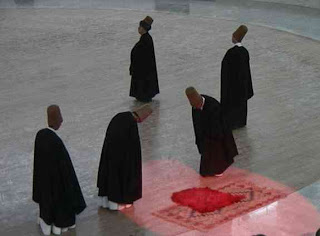After all of the groups arrived, the lights went low, and a drum sounded. Eleven men wearing cylindrical caps, black robes, and black soft sole shoes entered the area and stood at a corner adjacent to the instruments. One at a time, they entered the dance floor, nodded at the observers, and took a place on the floor in front of one of the raised seats or at the instruments. (The first 5 men went to the seats with the musical instruments.) The ritual began with a spoken eulogy to the Prophet. Then the drum sounded. Next a musician began playing on an instrument that looks like Kevin’s tune whistle—a wooden instrument which the player blew into. The pamphlet stated that the music is supposed to represent the breath of Allah bringing life to everything. That explained why the music sounded breathy instead of clear. Another musician began to play a second “tune whistle.” Then a third musician began to play a stringed instrument held on his lap which looked like an auto harp? Finally the drum joined in. The pamphlet said the musicians improvise here. Next the dancers rose, removed their black cloaks to reveal white garments beneath, and began a greeting ceremony.

One at a time they moved opposite the musicians—facing the observers in the raised seating and then turned to wait for the next dancer to come to that same place and nod at each other. So, in pairs they “greeted” each other and than moved counter-clockwise to the 4 corners of the dance floor until all 6 of them had entered the area and had greeted the dancer in line behind him. One of the dancers had not removed his black cloak. He seemed to be the director of the ensuing dance, but I never heard him speak to the dancers, and if he nodded to them, it was imperceptible.
Next, as if the director had cued them, one at a time, the men began to whirl. On some cue, the whirler would move and the next dancer would begin to whirl. They moved counter-clockwise around the dance floor until the first was in the middle and the others were at each of the 4 corners of the floor. The director moved among them, but he did not whirl as they did. At his cue the ones in the corners would move to the next corner while the one in the middle stayed in the middle. They continued to whirl until the director (or the music?) cued them to stop. The director cued one to begin again and the whole process of one whirling, then another joining, then another and another until all 5 were whirling and had moved counter-clockwise around the dance floor occurred again.

Then the director cued the dancers to stop and one by one they returned to their places on the floor in front of one of the raised seating areas, donning their black cloaks, bowing to the floor, and sitting on their knees. Then the director, who was still standing, recited from the Koran. His recitation included Sura bakara2, verse 115 which was translated for us in the pamphlet as: “Unto God belong the East and West, and wherever you turn, there is God’s countenance. He is all-embracing, all-knowing.”
Finally, the director prayed for pace for the souls of all the prophets and believers and one by one, in reverse order of their entrance, the dancers and musicians left—nodding at the observers before leaving the dance floor area.

The whirling was graceful. The men’s faces took on a look of peace and retreat from all but the dance. Being able to refer to the pamphlet as the dance progressed was very helpful for me. I could appreciate what I was seeing and could join in the worshipful aspect through the information provided in the pamphlet. Tonight was a high point in this trip.

No comments:
Post a Comment